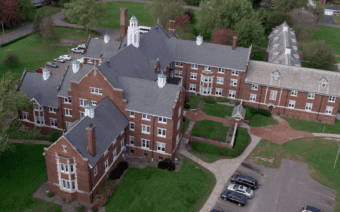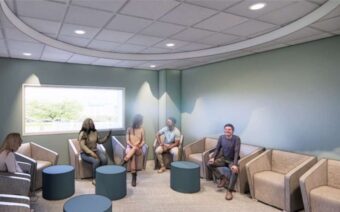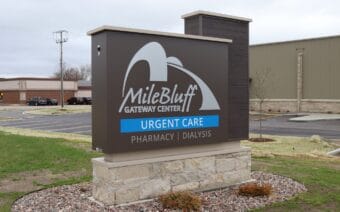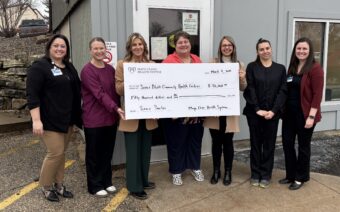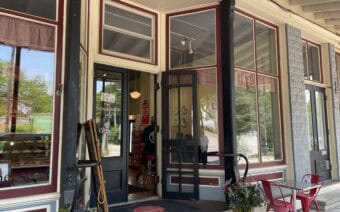
February 19, 2024
MAUSTON – When it comes to the long-term well-being of a community, Dara Bartels – president and CEO of Mile Bluff Medical Center – said one thing makes a critical difference: having access to local, independent health care.
Bartels said the kick-off of Mile Bluff’s Gateway Building construction project “speaks volumes to the importance of rural health care in Wisconsin.”
“I think it’s important to show that rural health care is important and that we are investing in ourselves,” she said.
Recognizing the recent pull-outs and downsizing of some systems in West Central Wisconsin, Bartels said it’s important to remember that Mile Bluff Medical Center is an independent organization.
“We are 70 miles away from bigger systems,” she said. “Putting money back into the community shows that we think it’s important to support our community – it really speaks to where we want to go with rural health care. I think Wisconsin needs to focus on what it thinks is ‘deadlands’ – there’s a lot of people out there, between cities, who need to be taken care of.”
Bartels said one of the things she takes pride in with Mile Bluff is that it takes into account what the community needs are.
“We make decisions in partnership with the community,” she said. “We’ve been able to make things a priority during these hard times – health care is going through a lot of stress right now after COVID-19 – but we’ve been able to stay strong and show we’re making the right decisions for the community.”
All of this, Bartels said, served as inspiration and motivation for the Gateway Building project.
The spark
Bartels said the impetus of the project came from a facility master plan Mile Bluff completed in December 2021.
“From (that), we saw the size of our ER, combined with the operation of our urgent care, as limitations,” she said. “That’s where things got started – (asking the questions), ‘what do we do with that information?’ and ‘how do we improve based on some of those pieces?’”
As discussions continued, Bartels said the best option to address those concerns uncovered through the master plan was to pull the urgent care services from the hospital setting.
Bartels said several things were discussed in the process.
“We looked at, ‘how are we going to serve the community better, serve our staff better with our ER and urgent care spaces being very busy?’” she said. “And then (how will that fit) into the future when we look at our master facility planning. The region’s population is getting older, we have a farming community, we have the interstate by us – how can we serve all that population through our ER more effectively?”
To help answer these questions, Bartels said they looked to the community.
“We’ve received community feedback about frustrations with the shared ER space,” she said. “We’ve also had concerns for staff because of the small, tight space.”
When the decision was made to relocate urgent care operations, Bartels said the next step was figuring out where the best place would be.
The space the former Shopko building offered, she said, was one of the things that stood out.
“We can design it ourselves,” she said. “Big box stores are open – giving us a lot of flow and allowing us to decide how we want patients to come through there.”
The property’s close proximity to downtown, Bartels said, was also appealing.
Purchasing the building in 2022, Bartels said the move made sense for Mile Bluff and the Mauston community.
“The big-box store was empty – making it not conducive to helping the community show its best light,” she said. “(We wanted) to have Mile Bluff be a staple of the community. I mean, we are now, but we’re on the outskirts – not really in the forefront. Uplifting the community with a beautiful building and having a presence in the main part of town, were two major pieces that helped us decide that was a great location.”
Project details
The Gateway Building will be home to Mile Bluff’s retail pharmacy, dialysis services and urgent care operations – each of which will relocate from its current Mauston location.
Bartels said one of the biggest things the project will accomplish is increased space – which will improve efficiency, privacy, safety and the overall experience for both patients and staff members.
“Currently, the pharmacy includes our durable medical equipment (DME) product line – (which includes) CPAP machines, aftercare items for mastectomy, some of those types of things – and right now, we don’t have a great place for people to test things out,” she said. “(At the new location), we’ll have better space for the DME that will serve the patients a lot better.”
The pharmacy’s current building, Bartels said, is also older and not conducive to a drive-thru.
Bringing Mile Bluff’s dialysis services out of the basement, Bartels said, is another positive aspect of the project.
“There’s no natural light – you have to go down the elevator to get there,” she said. “It worked for us for years, but when you start seeing the people we’re serving with dialysis in our plans of what we want to do with the clinic, we needed to get dialysis services out of there for both patient satisfaction and space planning.”
The relocation of Mile Bluff’s urgent care operations, Bartels said, creates many positives.
“Right now, we have space restraints,” she said. “Through the master facility plan, to keep the urgent care with the ER, we would have to push back into our hospital, which is extremely expensive. You’re also not commingling ER patients or trauma patients with urgent care patients anymore. After COVID-19, people worry about that.”
Once the urgent care facilities are out of the hospital, Bartels said the next phase of the project will start – the renovation of the ER.
“We will take the current urgent care space and make that another trauma bay per se and then open up the current room for emergency,” she said.
Bartels said the ER renovation will allow Mile Bluff to reconfigure the nurse’s station.
“Currently, our ER nurse’s station is exposed to the reception desk,” she said. “So, we’ve talked about privacy and security quite a bit. (The renovations) will help with staffing and with patients, so people are less likely to hear what’s going on.”
Bartels said the renovation will also help with the flow.
“It gives that space dedicated to the ER,” she said. “Planning will probably start in the next six months, and then we’ll go in once urgent care is out and do the remodeling for the ER.”
Timeline
Bartels said like any project, the expected timeline and the real timeline will always be different because of project delays, “and we’ve learned that through other projects we’ve done.”
“But, the plan is to have us moved into the Gateway Building in January 2025,” she said.
Following the groundbreaking at the beginning of last month, Bartels said the construction crew hit the ground running.
“They are in the building, and they are breaking up concrete and starting to get some of the HVAC items lined up,” she said.
People will start to see movement on the ER renovation project, Bartels said, around February or March of 2025.
“(The timeline of the ER project) will depend on what the plan is for the ER – whether it’s a moving of rooms or a full renovation,” she said. “That will start happening a month or two after the urgent care is moved out.”
Bartels said the ER project is anticipated to happen much quicker than the Gateway Building project because “we’re taking a big box store and converting it into a medical space.”
HSR Associates, Inc. out of La Crosse, Bartels said, is the project’s architect.
“We focused on them because we know they have experience taking a big box store and making it into medical space – the regulations and all that stuff in health care are stringent,” she said. “So, we pulled them in to help with that.”
Market and Johnson is serving as the project’s general contractor.
Naming rights
Bartels said the facility’s name – the Gateway Building – is temporary for a variety of reasons.
“Everyone calls it the Shopko building – we wanted to get away from representing a big box store,” she said.
The name, Bartels said, came from the facility’s location – “it’s located on Gateway Street.”
“There will, through fundraising, be naming right opportunities for that campus – of course, approved by the board,” she said. “But, we are opening that up for people to be inspired and be part of rural health growth and building renovations. We don’t have a name set. We are going to see what happens with fundraising opportunities, and if not, we’ll move into the next phase of naming the building.”
Project funding
The two-phased project is being funded through bonding and a capital campaign spearheaded by the Mile Bluff Medical Center Foundation.
Founded in 2010, Director Katie Nuttall said the foundation’s main purpose is to support local health care through the work of Mile Bluff.
“That means raising funds to support hospital building projects, for example,” she said. “We do scholarships for our healthcare employees. Raising funds to support new medical equipment that is above and beyond what normal operating budgets can support. We’ve done a lot with community health events – women’s night out, men’s night out and the last couple of years we’ve been mostly focusing on mental health and what we can do to empower our community to be mental health advocates.”
Nuttall, who has been with Mile Bluff since 2011, said when she took the position as foundation director almost three years ago, she knew a capital campaign would be coming down the pike soon.
“When I accepted the foundation director position, I knew a capital campaign would be soon on our horizon,” she said.
As a relatively young foundation, Nuttall said Mile Bluff has never done a capital campaign before, “so I knew we would need to call in some resources.”
“That started with partnering with Mcdonald Schaefer, a consulting company that does capital campaigns for a lot of different types of organizations,” she said. “We’ve been working with them for the better part of a year and a half.”
The first step in the process, Nuttall said, was doing a feasibility study.
“We knew we were going to do some sort of major construction project in the next couple of years and gauged what the community support would be,” she said. “All the information came back favorable, so we decided to go ahead with the capital campaign – to help support not only the Shopko to healthcare facility transition but also the remodeling of our emergency department.”
A capital campaign, Nuttall said, can take anywhere from 18 to 24 months.
“So with ours, with construction already started – our fundraising efforts are coinciding with the actual building projects,” she said.
Nuttall said she sees the foundation’s silent phase – “where we are talking to potentially larger donors” – taking place during the Shopko conversion phase of the project.
“Then the public phase – the fun events and things like that – that’ll probably more coincide with the ER remodeling this time next year,” she said.
Nuttall said foundations play an important role in any philanthropy efforts – especially in health care.
“We are supporting people in a lot of different stages of life,” she said. “We celebrate with them. We support them when they’re struggling and we hold their hands during times of grief and struggles, as well as end of life. We have a lot of people to express their gratitude for care. They want to make sure health care stays local, and they continue to have access to these services.”
This is when, Nuttall said, the foundation and philanthropic efforts come in.
“We are the channel where they can (do that),” she said.
The capital campaign’s goal, Nuttall said, is to raise $5 million – to support the project’s overall price tag of $17 million.
“The $5 million is (designed) to help offset costs and allows us to stretch our bond funding further,” she said.
Only actively fundraising in the silent phase since the beginning of December 2023, Nuttall said they are off to a good start.
“There’s quite a ways to go, but we’re making good progress,” she said.
Anyone interested in supporting the campaign, learning about naming right opportunities or getting involved can reach out to Nuttall directly at (608) 847-2735.
 ‘Reclaiming’ Grand Avenue through retail
‘Reclaiming’ Grand Avenue through retail Two artists + two dogs + woodworking + polymer clay = Fat Duck Designs
Two artists + two dogs + woodworking + polymer clay = Fat Duck Designs


